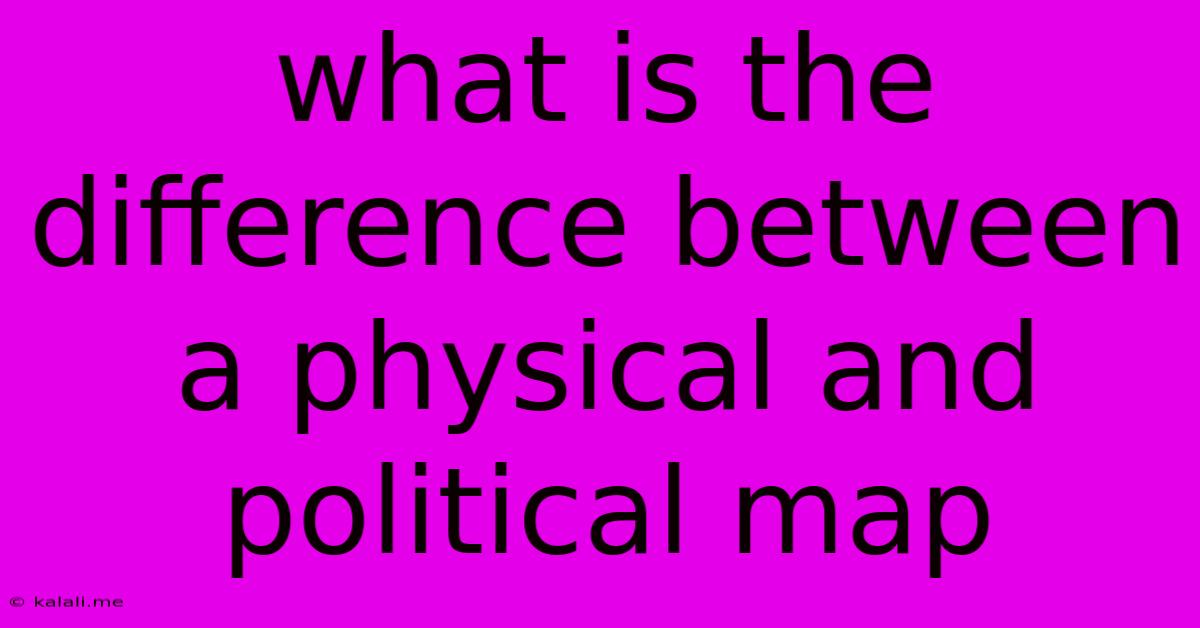What Is The Difference Between A Physical And Political Map
Kalali
Jun 14, 2025 · 3 min read

Table of Contents
Delving into the Differences: Physical vs. Political Maps
Choosing the right map for your needs depends on understanding the core differences between physical and political maps. While both display geographical information, they focus on vastly different aspects of the Earth's surface. This article will explore these key distinctions, helping you navigate the world of cartography with greater clarity. Understanding these differences is crucial for anyone needing to visualize geographical data, whether for academic research, travel planning, or simply satisfying curiosity about the world.
What is a Physical Map?
A physical map primarily illustrates the Earth's natural features. This includes landforms like mountains, valleys, plains, and deserts; bodies of water such as oceans, lakes, rivers, and seas; and variations in elevation. Think of it as a visual representation of the Earth's three-dimensional topography, flattened onto a two-dimensional surface. The purpose of a physical map is to give a visual representation of the planet's natural landscape and its geographical characteristics. Key elements often depicted include:
- Terrain: Mountains are usually shown with shading or different colors to represent elevation, while valleys are indicated by contour lines or shading.
- Water bodies: Oceans, seas, lakes, and rivers are clearly marked, often using different shades of blue to represent depth or water flow.
- Vegetation: Some physical maps may also include information about vegetation zones, such as forests, grasslands, and deserts.
- Elevation: Contour lines or color gradients often show the changes in elevation across the landscape.
What is a Political Map?
Unlike its physical counterpart, a political map focuses on human-created boundaries and divisions. It highlights the geographical distribution of political entities such as countries, states, provinces, and cities. The primary aim is to display the organization of human settlements and political control over specific areas. Political maps are essential tools for understanding geopolitical relations, migration patterns, and the distribution of resources. Important elements include:
- Country borders: Clearly defined lines separate nations and territories.
- State/Provincial boundaries: Internal divisions within countries are also shown.
- Capital cities: Usually marked with a star or a specific symbol.
- Major cities: Important urban areas are often labeled.
- Other points of interest: Some political maps include points of interest such as national parks, airports, or significant historical sites.
Key Differences Summarized:
| Feature | Physical Map | Political Map |
|---|---|---|
| Focus | Natural features (landforms, water bodies) | Human-made boundaries (countries, states) |
| Purpose | Show Earth's topography and natural landscape | Show political divisions and human settlements |
| Key Elements | Mountains, valleys, rivers, oceans, elevation | Country borders, state lines, cities, capitals |
| Color Schemes | Often use varying colors for elevation/terrain | Often use different colors for different countries |
| Information | Primarily geographic and environmental data | Primarily political and administrative data |
Combining Physical and Political Map Data:
While distinct, physical and political information isn’t mutually exclusive. Many maps effectively combine both types of data, providing a comprehensive overview. These hybrid maps allow for a better understanding of how human settlements and political boundaries interact with the natural environment. For example, a map showing the distribution of population density overlaid on a physical map revealing mountain ranges can illuminate how geography influences population distribution.
Understanding the fundamental differences between physical and political maps empowers you to choose the most appropriate map for your specific needs, enhancing your comprehension of geographical information and its significance. Whether you're a student, a traveler, or simply someone fascinated by the world, knowing these distinctions is key to effective map reading.
Latest Posts
Latest Posts
-
What Organelle Has Its Own Dna
Jun 14, 2025
-
College Of The Ozarks Application Deadline
Jun 14, 2025
-
Which Option Is A Renewable Resource
Jun 14, 2025
-
Least Common Multiple Of 6 8 And 15
Jun 14, 2025
-
One Gram Of Fat Provides How Many Calories
Jun 14, 2025
Related Post
Thank you for visiting our website which covers about What Is The Difference Between A Physical And Political Map . We hope the information provided has been useful to you. Feel free to contact us if you have any questions or need further assistance. See you next time and don't miss to bookmark.